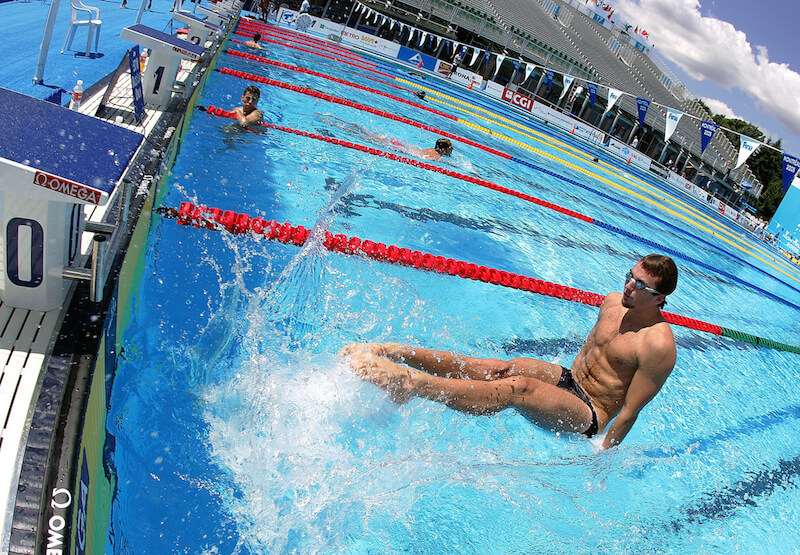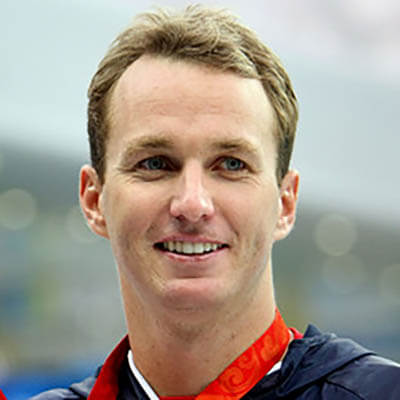LumaLanes Split Time Analysis: Aaron Peirsol’s 200 Backstroke World Record

Analysis of the men’s 200 Long Course Meters backstroke is sponsored by LumaLanes.
The 2009 FINA world championships, dubbed “The Shiny Suits Circus” and “The Plastic Fantastic Games”, are well-known for the absurd number of swimming world records – 43 in all – which fell during eight days of racing. Non-textile bodysuits made from materials such as polyurethane placed the pace of the sport on an artificial fast-forward.
Today, we will be looking at one of those records which has not been significantly challenged in the 11 years since those championships: the men’s 200 backstroke. Included in the analysis will be the four fastest performers of all-time – Aaron Peirsol, Ryosuke Irie, Ryan Lochte, and Mitch Larkin.
- Peirsol, 2009 World Championships, Rome – 26.52, 54.90 (28.38), 1:23.30 (28.40), 1:51.92 (28.62) WR
- Irie, 2009 World Championships, Rome – 26.79, 55.61 (28.82), 1:24.63 (29.02), 1:52.51 (27.88)
- Lochte, 2011 World Championships, Shanghai – 26.66, 55.50 (28.84), 1:24.03 (28.53), 1:52.96 (28.93)
- Larkin, 2015 World Cup, Dubai – 26.39, 55.16 (28.77), 1:24.66 (29.50), 1:53.17 (28.51)
Analysis

Aaron Peirsol – Photo Courtesy: Jed Jacobsohn
After the first fifty meters, it is Larkin in the lead, though Peirsol is only .13 seconds behind. With Peirsol being the fastest of these four in the 100 back, it was surprising that he did not have the lead at the first turn (though there were many pace anomalies in many races across the board, Rebecca Soni’s 200m breaststroke fourth-place performance among outstanding examples of how swimmers were still learning how to cope with a suit that had taken over their performance norms).
The second lap is all his. Peirsol pushes a 28.38 to close out his first hundred meters, the fastest second fifty split by .39. Larkin remains in second, with Lochte and Irie trailing closely behind. The third fifty of the race really highlights the two American swimmers and their backstroke prowess. Both Peirsol and Lochte split 28-mids, while Irie popped a 29.0 and Larkin dropped off all the way to 29.5. With that split, Lochte has now moved into second with Irie also passing Larkin.
The final lap is like a coronation for Peirsol, the backstroke king. While his 28.62 was the slowest of his splits, it was enough to make him the first and only man to swim the two-hundred meter backstroke in under 1:52.00. After easing up a bit on the third fifty, Irie unleashed a 27.88 final fifty to pass Lochte like he was standing still. Lochte’s 28.9 final fifty was good enough to keep him under the 1:53.00 mark, which is a club of only three members. Larkin recovered nicely to close in a 28.5, second fastest amongst the four racers.
Looking Forward
If we assign the numbers 1, 2, and 3 to each swimmers second, third, and fourth lap in terms of time (1-fastest), it looks something like this:
- Peirsol – 1, 2, 3
- Irie – 2, 3, 1
- Lochte – 2, 1, 3
- Larkin – 2, 3, 1
What is interesting to note is that both Peirsol and Lochte had their slowest fifty on the last segment, whereas that portion of the race was the quickest for Irie and Larkin. Perhaps that points towards the Americans’ confidence to be able to take a race out hard rather than doubt their abilities. Maybe the Australian and Japanese age-groupers are taught to always finish much faster than than their previous laps. Or, this sample size is too small and these patterns are completely based on a swimmers’ own ability and training. And, of course, there is the shiny suit, which caused many swimmers to depart from their normal approaches to races.
If a swimmer were to hope to break this world record, the key part of the race would definitely be the second 100 meters, that part where, without the shiny suit, some swimmers who kept rolling would, the evidence clearly suggests, not have been able to keep moving at that same fast-forward pace.
With swimmers such as Ryan Murphy, Xu Jiayu, and Evgeny Rylov all breaking the 52-second barrier in the sprint backstroke race since 2016, there is no shortage of front-end speed in the 200 backstroke these days. In order to conquer the longer backstroke race, however, it will most likely take a swim that includes both first-half speed and the ability to split 28-mid-to-lows on the back half – something that is not impossible for any of the world’s best backstrokers in the foreseeable future.
Learn more about LumaLanes



